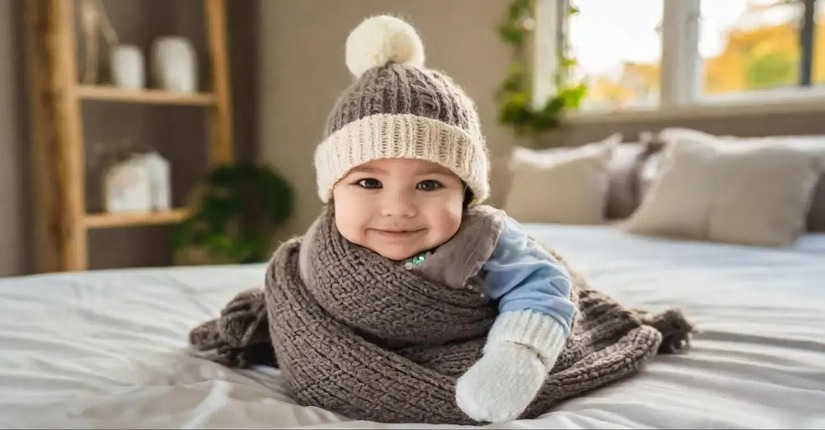How to Protect Babies from Cold Weather – Essential Tips
Winter can be a magical season, but for parents of young children, it brings unique challenges. Babies are more vulnerable to cold weather because their bodies are still developing and they lose heat faster than adults. Knowing how to protect babies from cold weather is crucial to keeping them safe, warm, and healthy during the colder months.
1. Dress Your Baby in Layers
When heading out in cold weather, layering is key. Dress your baby in layers to trap warm air and provide insulation. Start with a snug-fitting base layer made of moisture-wicking material, followed by a warm middle layer like fleece or wool. Top it off with a windproof and waterproof outer layer.
Tips for Layering:
- Ensure the layers are not too tight, as this can restrict movement and circulation.
- Use mittens, hats, and booties to cover extremities where heat loss is most significant.
- Always check your baby’s neck or back to ensure they’re warm but not overheating.
2. Choose the Right Fabrics
Not all fabrics are created equal when it comes to winter protection. Cotton, while soft, can retain moisture and make your baby cold. Opt for wool, fleece, or synthetic blends designed for winter wear. These materials provide excellent insulation and wick moisture away from the skin.
3. Keep Your Baby’s Head and Feet Warm
Babies lose a significant amount of heat through their heads and feet. Always cover their heads with a soft, snug hat and use insulated socks or booties to keep their feet warm.
Additional Tip:
- For newborns, use hats with ear flaps for added protection against chilly winds.
4. Avoid Overheating
While it’s important to keep your baby warm, overheating can be just as dangerous. Overbundling can lead to sweating, which makes your baby feel cold when exposed to the chilly air. Monitor your baby’s temperature by touching their neck or chest and adjust layers accordingly.
5. Create a Warm Sleep Environment
Protect babies from cold weather indoors by ensuring their sleeping area is cozy and safe. Use a warm sleeping sack instead of loose blankets, which can pose a suffocation risk. Keep the room temperature between 68°F and 72°F (20°C to 22°C).
Important Note:
- Avoid placing your baby’s crib near windows or drafty areas.
- Use a humidifier to prevent dry air from irritating their skin and respiratory system.
6. Limit Outdoor Exposure
In extremely cold weather, it’s best to limit your baby’s time outdoors. If you must go out, bundle your baby appropriately and keep outings short. Shield them from direct wind and ensure they’re not exposed to wet conditions.
7. Use a Baby Carrier Cover
A baby carrier cover can provide an extra layer of warmth when you’re on the go. These covers are designed to fit over your baby carrier and protect your baby from wind, rain, and snow. Look for options with fleece lining for added insulation.
Pro Tip:
- Avoid covering your baby’s face with blankets or covers, as this can restrict airflow.
8. Keep Skin Hydrated
Cold weather can dry out your baby’s delicate skin, leading to irritation and chapping. Use a gentle, baby-safe moisturizer after baths and before heading outdoors to lock in moisture. Pay extra attention to their cheeks, hands, and lips, which are most exposed to the elements.
9. Monitor for Signs of Cold Stress
Babies can’t tell you when they’re cold, so it’s essential to watch for signs of discomfort. Symptoms of cold stress include:
- Cold or pale skin
- Shivering
- Fussiness or lethargy
- Cool hands and feet
If you notice any of these signs, bring your baby indoors immediately and warm them up gradually.
10. Keep Immunizations Up-to-Date
Winter is also flu season, so protecting your baby’s health includes keeping their immunizations current. Consult your pediatrician about the flu vaccine and other recommended vaccinations to safeguard your baby’s immune system.
11. Practice Safe Bathing
Bathing your baby during winter requires extra care. Use lukewarm water instead of hot water to prevent drying out their skin. Keep the bathing area warm and wrap your baby in a towel immediately after their bath to avoid heat loss.
12. Stay Prepared for Emergencies
Winter weather can be unpredictable, so it’s essential to have an emergency kit ready. Include items like warm blankets, extra clothing, baby-safe hand warmers, and essential supplies in case of power outages or travel delays.
Conclusion
Knowing how to protect babies from cold weather is vital for every parent. By dressing them in layers, choosing the right fabrics, and monitoring their temperature, you can ensure your baby stays warm and comfortable throughout the winter. Combine these tips with good indoor practices like maintaining a warm sleep environment and hydrating their skin, and you’ll be well-prepared to tackle the chilly months ahead. Protecting your baby from the cold not only ensures their comfort but also supports their overall health and happiness during this magical season.


0 Comment